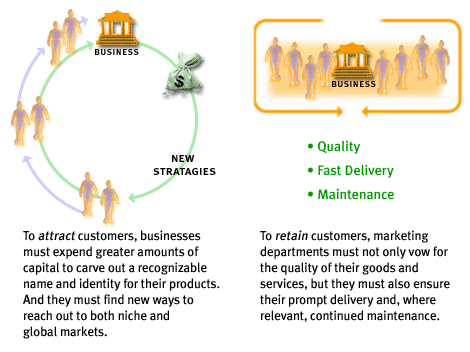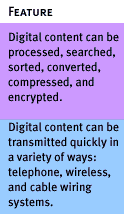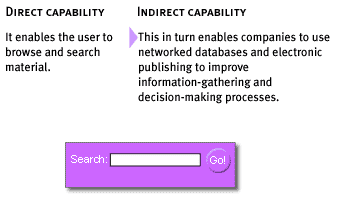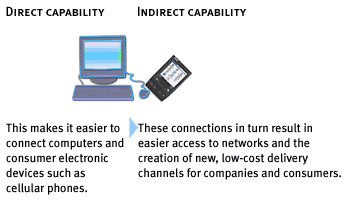| Lesson 2 | Why build an eBusiness solution? |
| Objective | Describe market trends/business drivers that make eBusiness compelling. |
Benefits of building an e-business Solution
In order to understand and weigh the reasons for building an e-business solution for your business, it is important that you know the general drivers and forces associated with e-business. There are three such forces behind the growth of e-business:
- Changing productivity
- Shifting market scenarios
- Rapidly evolving technologies
Productivity and Reduce Costs
One of the principal drivers behind any business is the need to reduce costs and stay competitive. In fact, many pundits cite the long-term, technologically driven improvement in productivity as the key reason underlying the healthy economy and robust stock markets of the latter 1990s. To stay economically efficient companies must enhance productivity, and they must focus on both their external and internal operations, as outlined below.
| Outward-looking initiatives may focus on: | Technological infrastructures Electronic transactions with suppliers Global information sharing and advertising Customer service |
| Inward-looking initiatives may focus on: | Customer requests Shipping Billing Inventory Electronic data storage that allows for instant retrieval and transmission |
In developing an e-business solution, organizations can improve their productivity and efficiency, both within the organization and in their external customer and supplier transactions.
Market Scenarios
In recent years, the number of businesses, whether they are traditional storefronts, catalog suppliers, or online businesses, have proliferated.
Customers have more choice in what they purchase and who they purchase it from than at any other time in history. In order to remain competitive, marketing executives must work hard both to attract and retain customers, as illustrated below.
Data-Driven Marketing

e-business therefore offers a new channel for attracting business opportunity. Just as e-business provides techniques to improve productivity and efficiency (that is, reduce cost), it also offers new ways to drive revenue (that is, increase opportunity). In short, the Web brings an entirely new set of opportunities, and challenges, to the marketing of a company's products.
Application of Technology to e-business
The last driving force behind e-business is technology. The popularity of Web-based technology has resulted in an explosion in Digitized content[1]. This explosion has generated new technologies, which have affected many industries, but especially content-intensive industries such as publishing. The table below explains the effects that digital content has had on both users and entire industries.
Digital Content and Direct Digital Marketing
Direct digital marketing is marketing through an email address, a web browser or a mobile phone number.
Traditional direct marketing was achieved using a postal address of the customer . Traditional marketing communications are divided into two primary types:
- direct marketing and
- mass marketing.
- Mass marketing is a marketing method that broadcasts a message to a large audience.
- The marketing message is not addressable, and is not easily tracked and measured.
- Online marketing is a marketing method that uses Internet tools such as email, search engine optimization and banner ads to send marketing messages to consumers.
- Mobile marketing is a marketing method that allows marketers to send marketing messages to consumers through the technologies found on the mobile device of a consumer. Consumers opt in to receive messages.
- Email marketing is a marketing method that uses email to send a marketing message to a targeted audience.
Advanced Digital Architectures
Digital Content


- Direct capability: It enables the user to browse and search material.;
- Indirect capability: This in turn enables companies to use networked databases and electronic publsihing to improve information-gathering and decision-making processes.
For example: Search input textbox enables the user to browse and search material.

- This makes it easier to connect computers and consumer electronic devices such as cellular phones. Lan cables and wifi enable direct capability and connectivity.
- Indirect capability: These connections in turn result in easier access to networks and the creation of new, low cost delivery channels and consumers
The Opportunity of e-business
Due to these developments in productivity, market scenarios, and technology, the lines between the communications, entertainment, publishing, education, and computing industries are beginning to vanish. Businesses, now forced to reevaluate their positions within the marketplace, have two choices.
- They can ignore these developments and continue conducting business in the way they have for years.
- They can capitalize on the wealth of opportunities that the convergence of these forces has created, namely the creation of new service delivery channels like transaction processing; the development of new markets for existing products; and the development of new information-based products for an online environment.
[1]
Digitized Content: Content that is broken down into and transmitted in digitally.